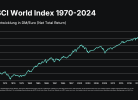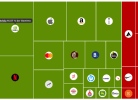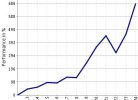By Mitch Zacks
The S&P 500 suffered its biggest decline of 2019 on Monday (August 5), declining -3.3% while the tech-heavy Nasdaq fell -3.8%.
When the market takes a sudden and sharp turn, investors often get rattled and start questioning their asset allocation. Getting worried and second-guessing is a normal, natural, and understandable response. But if you’re feeling the urge to react and ‚do something about it,‘ I’d strongly urge you reconsider. If your goals have not significantly changed in the last week, then in all likelihood, your investment portfolio shouldn’t change either.
Basing an asset allocation decision on short-term market movements is almost always harmful to an investor’s pursuit of their long-term goals, in my experience. But I also have data to prove it. The research firm Dalbar consistently finds that equity fund investors, on average, are significantly underperforming the S&P 500, bonds, commodities, and even inflation over long stretches of time. The reason: poor market-timing decisions. Being patient and staying focused on where you want to be 10, 20, or even 30 years from now is a better response, in my view.
Before I dive into some of the triggers/causes of recent market volatility (which I’ll do below), I want to offer readers a reminder of how downside volatility and market corrections look. Even if you look back on just the past two years, there have been three fairly sharp pullbacks, and one of them flirted with bear market territory. Is it possible the current downside will persist and take us into double-digit territory? Of course. But recent history shows that the market recovered after each pullback as the economy continued to grow. Looking ahead for the balance of 2019, we continue to see an economy poised to grow, even if just at a modest pace.
In the three pullbacks shown below, the first and second ones lasted about two months and the smaller decline transpired in about a month’s time. Which is to say, we should reasonably expect the current downside volatility to continue for some time.
The S&P 500 Since January 1, 2017 – 3 Significant Pullbacks

Source: Federal Reserve Bank of St. Louis4
Another takeaway from looking at the chart above is that equity market recoveries often happen in „v-shaped“ patterns, which means in many cases, the recovery can happen just as quickly as the decline. It is for this reason that trying to time a market correction is such a difficult, and in my view, a dangerous endeavor. Mistiming your re-entry even by one day can have a substantial impact on total return. In my view, the opportunity cost of market timing is simply too high.
Why Did the Market Sell Off?
One of the reasons I’m convinced this downside volatility is a correction (and not a bear market) is that the most-cited source of the volatility is an old story: the U.S. – China trade dispute. Though there are new developments in the trade impasse – and to be sure they are not good developments – this is still a story that’s been out in the open for over a year. The market may be repricing the negative developments, but I do not suspect the economic outlook for growth has shifted considerably to the downside.Trade accounts for less than 10% of U.S. GDP.
So, what changed? Late last week, the Trump Administration said they planned to add a 10% tariff on an additional $300 billion of Chinese goods, and this week the Chinese responded by allowing its currency to depreciate below 7 yuan to the dollar – a considerable decline. China also halted imports of U.S. agricultural goods, which runs counter to earlier indications that they were planning to increase purchases. The U.S. responded by labeling China a currency manipulator, which is largely a cosmetic move today, but still will require a year of negotiations and may involve some penalties on China if proved.
Bottom Line for Investors
It has become clear over these last few months that the probability of a grand trade deal in 2019 is approaching zero, which I believe the market has already priced in. Perhaps the best we can hope for, in my view, is no more negative surprises and constructive dialogue going forward. Time will tell, but our best-case remains that the U.S. economy will continue to grow in 2019. I think patience is warranted now as a result, even if the volatility continues (which I believe it will).
At the end of the day, market volatility often serves as a wake-up call for investors, in some cases calling into question your asset allocation and whether you may have too much risk/exposure in your portfolio. That’s a normal and even healthy response, in my view. Volatility can serve as an opportunity to review your asset allocation and make sure your portfolio is diversified and aligned with your long-term goals.
In times like this, I believe it is best to focus on the fundamentals instead of getting caught up in perceptions.
Wenn du keinen Beitrag mehr verpassen willst, dann bestell doch einfach den Newsletter! So wirst du jedes Mal informiert, wenn ein neuer Beitrag erscheint!








Bemerkenswert finde ich die Aussage, dass das Scheitern der Verhandlungen schon eingepreist sein soll?!?
Der Markt ist jetzt immer noch mehr oder weniger am Höchststand, die Gewinne sind insgesamt auch eher zurückgekommen (S&P500) – wo und was genau soll der Markt daher bereits eingepreist haben?
Ist die Meinung von Mitch. Ich schätze seine Meinung, habe aber auch eine eigene. Wie ich den Markt einschätze, habe ich vor 10 Tagen in meinem Text dargelegt.